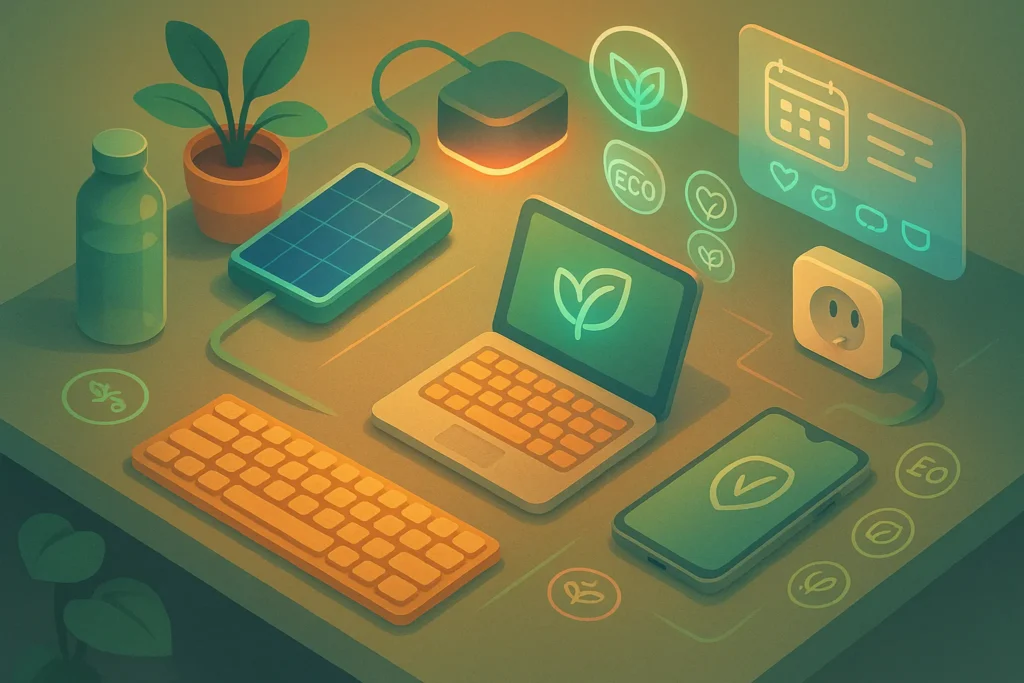🌍 Introduction: Green Tech Is No Longer Optional
In 2025, being tech-savvy means more than having the latest gadgets—it means choosing devices that reflect your values. As environmental concerns escalate, more people are looking for ways to align their digital lifestyle with sustainability. The good news? You don’t have to give up convenience to go green.
From solar-powered chargers and biodegradable phone cases to laptops made from recycled aluminum, eco-friendly gadgets are no longer niche—they’re a movement. And it’s growing fast.
This guide highlights some of the best sustainable tech you can use right now—plus smart tips to reduce your footprint without sacrificing performance. Whether you’re a minimalist, digital nomad, or power user, there’s something here for you.
🔋 Solar-Powered Chargers & Power Banks
In a world where energy use is under the spotlight, solar-powered chargers offer an elegant solution: charge your devices using free, renewable energy from the sun. Whether you’re commuting, hiking, or working off-grid, these gadgets reduce reliance on fossil-fueled electricity—making your tech life a little greener every day.
Swapping out your regular charger for a solar-powered one is one of the easiest steps toward greener tech use.
✅ Why it’s eco-friendly:
Solar chargers reduce dependence on grid electricity, especially when charging small devices like phones, tablets, or headphones.
✅ Real Use Case:
Backpackers and remote workers use solar banks like the Anker 21W Solar Panel Charger to stay powered without relying on fossil-fuel-powered electricity grids.
✅ Bonus Tip:
Look for models with smart charging technology that adjust output for different devices, improving efficiency.
As smart cities evolve and eco-conscious living goes mainstream, tech is becoming the bridge between innovation and sustainability. We explored this concept further in Smart Cities: How AI and IoT Are Shaping Urban Life—a must-read for anyone curious about large-scale green tech solutions.
🔌 Smart Plugs with Energy Monitoring
Most of us waste electricity without even noticing—smart plugs with energy monitoring help you see where it’s happening. By measuring real-time usage and offering control via apps or voice assistants, they turn passive consumption into active optimization, helping you cut costs and reduce your carbon footprint.
Smart plugs aren’t just for automation—they can help you spot energy waste and cut it off at the source.
✅ Why it’s eco-friendly:
They help reduce phantom power consumption (standby energy use) and can automatically shut down devices when not in use.
✅ Pro Pick:
The TP-Link Kasa Smart Plug with Energy Monitoring offers detailed usage insights. Pair it with solar panels for double impact.
🧠 Want to go further? Combine these with tips from our Smart Home Gadgets post for a fully optimized eco-tech lifestyle.
📱 Biodegradable Phone Cases
Your phone case might be protecting your device—but is it protecting the planet? Traditional plastic cases stick around for centuries, while biodegradable ones break down naturally. They’re a simple but powerful switch for anyone who wants their everyday accessories to match their eco-values.
Most phone cases are made of petroleum-based plastic that ends up in landfills. But now you can protect your phone and the planet.
✅ Why it’s eco-friendly:
Biodegradable cases like those from Pela or Incipio Organicore break down naturally, without releasing toxins.
✅ Good to Know:
Some brands even offer take-back programs for old cases.
🔁 For gift ideas in this space, check out our Tech Gift Guide: Gadgets for Every Budget.
💻 Laptops Made with Recycled Materials
Modern laptops don’t just have to be powerful—they can be planet-positive too. Brands are now designing devices with recycled aluminum, plastics, and even ocean waste, proving that high performance and environmental responsibility can go hand in hand. Every purchase becomes a vote for circular design.
Leading brands are finally incorporating sustainability into mainstream hardware. Some laptops now use recycled aluminum, ocean-bound plastics, and even modular design for easier repair.
✅ Top Brands:
-
Framework Laptop: Modular and repairable by design.
-
HP Dragonfly G4: Uses ocean-bound plastics.
-
Apple MacBook Air (M2): Aluminum made from 100% recycled materials.
✅ Why it matters:
Electronics manufacturing is one of the most carbon-intensive processes in consumer tech. Choosing low-impact materials makes a real difference.
📌 Nerd Tip: Look for EPEAT or ENERGY STAR certifications when buying laptops.
For a more global view on how technology is being used to fight climate change, check out AI vs Climate Crisis, where we examine AI-powered farming, energy grids, and even carbon forecasting.
Quick Comparison Table: Eco Materials vs Traditional Tech
| Component | Standard Material | Eco Alternative | Environmental Impact |
|---|---|---|---|
| Laptop casing | Virgin aluminum | Recycled aluminum | ~95% less energy to produce |
| Keyboard shell | ABS plastic | Ocean-bound plastic | Helps reduce marine pollution |
| Packaging | Plastic foam | Molded paper pulp | Fully biodegradable and compostable |
🧠 Green Tech Myth Buster Box
🧠 Green Tech Myth Buster
- “Eco gadgets are low-performance” → Not true. Many are built to last longer, with better energy efficiency and modularity.
- “Solar chargers are useless indoors” → False. Some modern solar banks can pre-charge from daylight and hold power for days.
- “Recyclable means compostable” → Nope. These are different. Not all biodegradable materials are home-compost safe.
🔖 Certified Sustainability Labels to Look For
If you want to buy green tech with confidence, keep an eye out for verified eco-certifications:
| Label | What It Means |
|---|---|
| ENERGY STAR | Meets strict energy efficiency standards |
| EPEAT | Rated based on lifecycle, recyclability & energy use |
| FSC Certified | Wood/plastic sourced from responsibly managed forests |
| Climate Neutral Certified | Company offsets entire carbon footprint |
🧠 Insight: These labels make it easier to compare products based on measurable sustainability—not just marketing claims.
And if you’re optimizing your home for greener living, pair this post with our Smart Home Gadgets list to make every room more efficient.
♻️ Lifecycle Impact: From Production to Disposal
A truly eco-friendly gadget isn’t just green on the surface—it has to be responsible throughout its entire lifecycle. That includes using renewable energy in manufacturing, enabling repair and upgrades, and offering recycling or trade-in programs. Looking at the full journey helps us choose tech that does less harm, from start to finish.
A gadget’s sustainability doesn’t begin and end with its materials. To truly understand its environmental impact, you have to consider its entire lifecycle—from raw materials to recycling.
🔄 Key Lifecycle Questions:
-
Production: Does the brand use renewable energy in its factories?
-
Repairability: Can parts be replaced without discarding the entire device?
-
Recycling Programs: Is there a take-back, buyback, or recycling initiative?
🏷️ Notable Brand Initiatives:
-
Apple: Offers a robust Trade-In Program and uses renewable energy across all facilities.
-
Dell: Their Asset Recovery Program helps recycle old devices.
-
Fairphone & Framework: Built with modularity in mind—easy to upgrade or repair.
🌿 Choosing brands that consider end-of-life impact ensures your devices don’t contribute to tech waste mountains.
📬 Want More Eco-Tech Like This?
Join our free newsletter and get weekly insights on sustainable gadgets, smart energy tips, and planet-positive tech innovations—delivered straight to your inbox.
No fluff. Just high-quality content for mindful makers and eco-conscious tech lovers.
🔐 100% privacy. No spam. Just real green tech insights from NerdChips.
🌱 Green Tech Brands to Watch
Some brands aren’t just selling sustainable products—they’re reshaping the industry. From modular laptops to fair-trade smartphones, these companies embed sustainability into every decision they make. Supporting them means accelerating a better standard for how tech is made, used, and reused.
Some companies aren’t just building gadgets—they’re redefining what sustainable tech can be. If you’re building an eco-friendly setup, these brands deserve your attention:
🛠️ Framework
-
What they do: Modular laptops you can repair, upgrade, or customize.
-
Why it matters: Keeps hardware out of landfills and promotes a circular economy.
📱 Fairphone
-
What they do: Ethically sourced smartphones with repairable components.
-
Why it matters: Combines social sustainability (fair labor) with environmental goals.
🖱️ Logitech (Climate Positive line)
-
What they do: Produces peripherals with recycled plastics and low-carbon shipping.
-
Why it matters: First major tech brand to go climate positive.
🧠 Don’t forget: You can also explore brand-specific sustainability pages for deeper insights. Many now publish transparent reports and carbon goals.
⚙️ Smart Use Tips to Maximize Sustainability
No matter how eco-friendly your gadgets are, how you use them still matters. Thoughtful settings, smarter charging habits, and reducing idle energy waste can dramatically extend device life and lower your overall footprint. Sustainability isn’t just about what you buy—it’s about what you do after.
Even the greenest gadgets still use energy and resources. But you can extend their lifespan and reduce their impact with a few smart habits:
🔋 Charge Smarter
Use timers or smart plugs to avoid overcharging. This extends battery life and cuts energy waste.
🌙 Turn On Power-Saving Modes
Most devices have eco-modes—use them! Dimming screens and reducing background processes helps.
🔌 Avoid Phantom Power
Unplug chargers when not in use, or use smart strips to cut standby power.
🛠️ Maintain & Update
Keep software up to date to improve performance. Dust off vents, clean screens, and treat your tech with care.
These little habits add up—and you’ll find more like them in our post on Top 10 Must-Have Gadgets for Productivity, where efficiency meets smart usage.
🌿 Micro Actions You Can Take Today
🌿 3 Things You Can Do Today
- Swap one charger with a solar-powered one
- Use smart plugs to cut standby power at night
- Look up the EPEAT or ENERGY STAR rating of your current laptop
Small steps. Big difference—especially when done consistently.
⚠️ Quick Warning About Greenwashing
This can be placed near the “Certified Sustainability Labels” section:
⚠️ Not all ‘eco’ labels mean what they say.
Some brands use vague terms like “eco-friendly” or “green packaging” without providing any third-party verification or lifecycle impact data. Always check for legit certifications like ENERGY STAR or Climate Neutral, and don’t fall for marketing fluff.
🧠 Nerd Verdict
Eco-friendly tech is no longer a niche—it’s the future of innovation. From the materials in your laptop to how your charger draws power, every choice adds up. The tools are here, the brands are evolving, and the awareness is growing.
This isn’t about perfection—it’s about better habits and smarter decisions. Start with one swap: a biodegradable case, a solar charger, or even a modular device. Over time, these choices shift your impact—without losing the convenience, speed, or creativity that tech makes possible.
In 2025, sustainability and performance no longer have to be trade-offs. They’re finally becoming the same thing.
❓ FAQ: Nerds Ask, We Answer
💬 Would You Bite?
Have you already started building an eco-friendly gadget setup?
Which green tech brands or products have impressed you most?
Drop your experience or wishlist in the comments—we’re always looking for new sustainable finds 🌿



